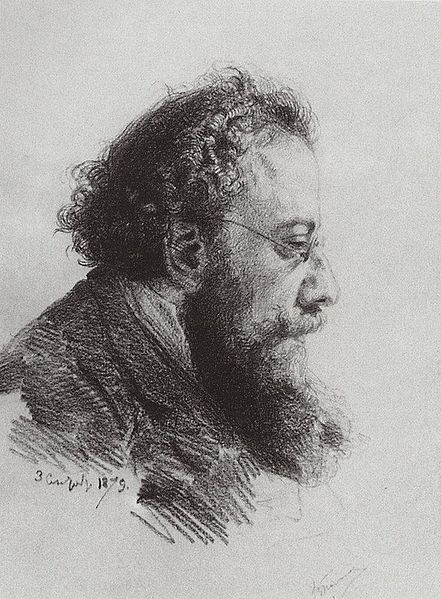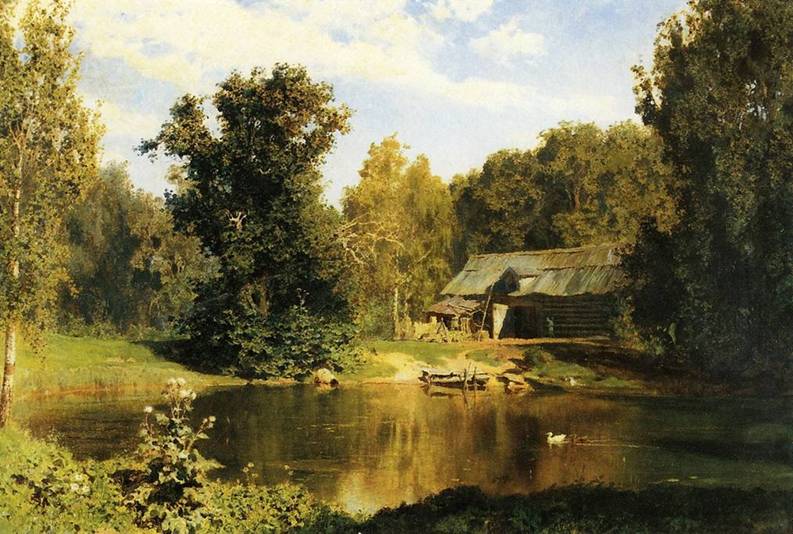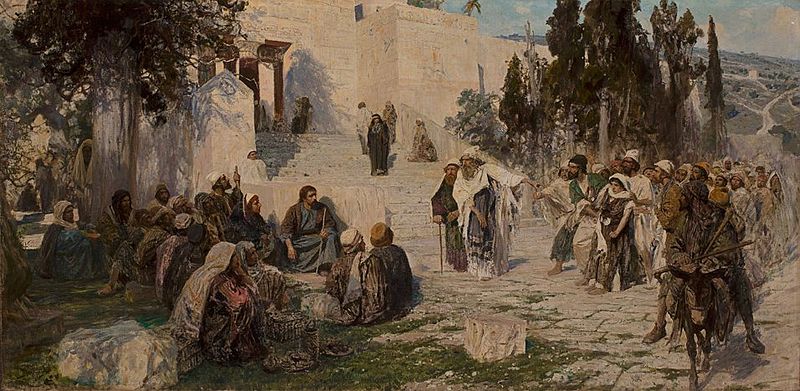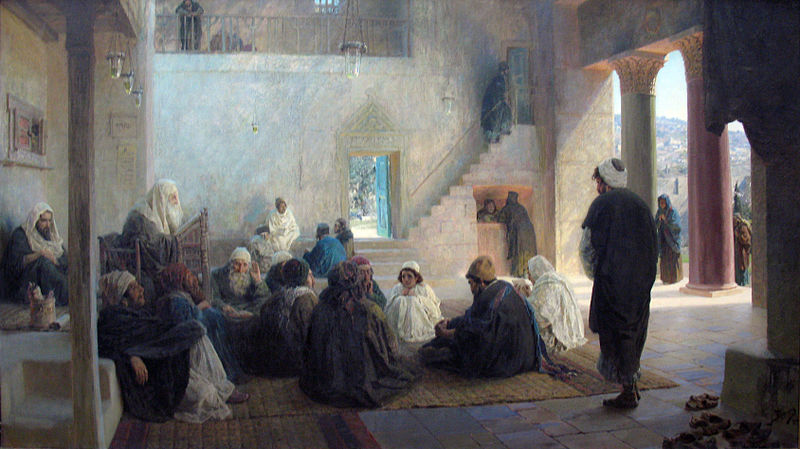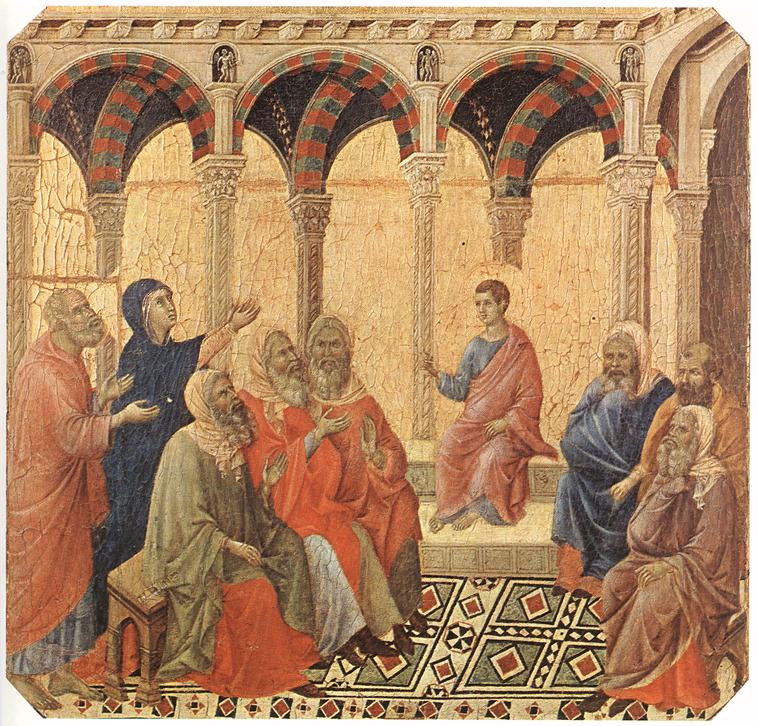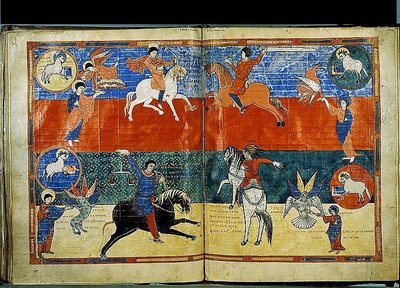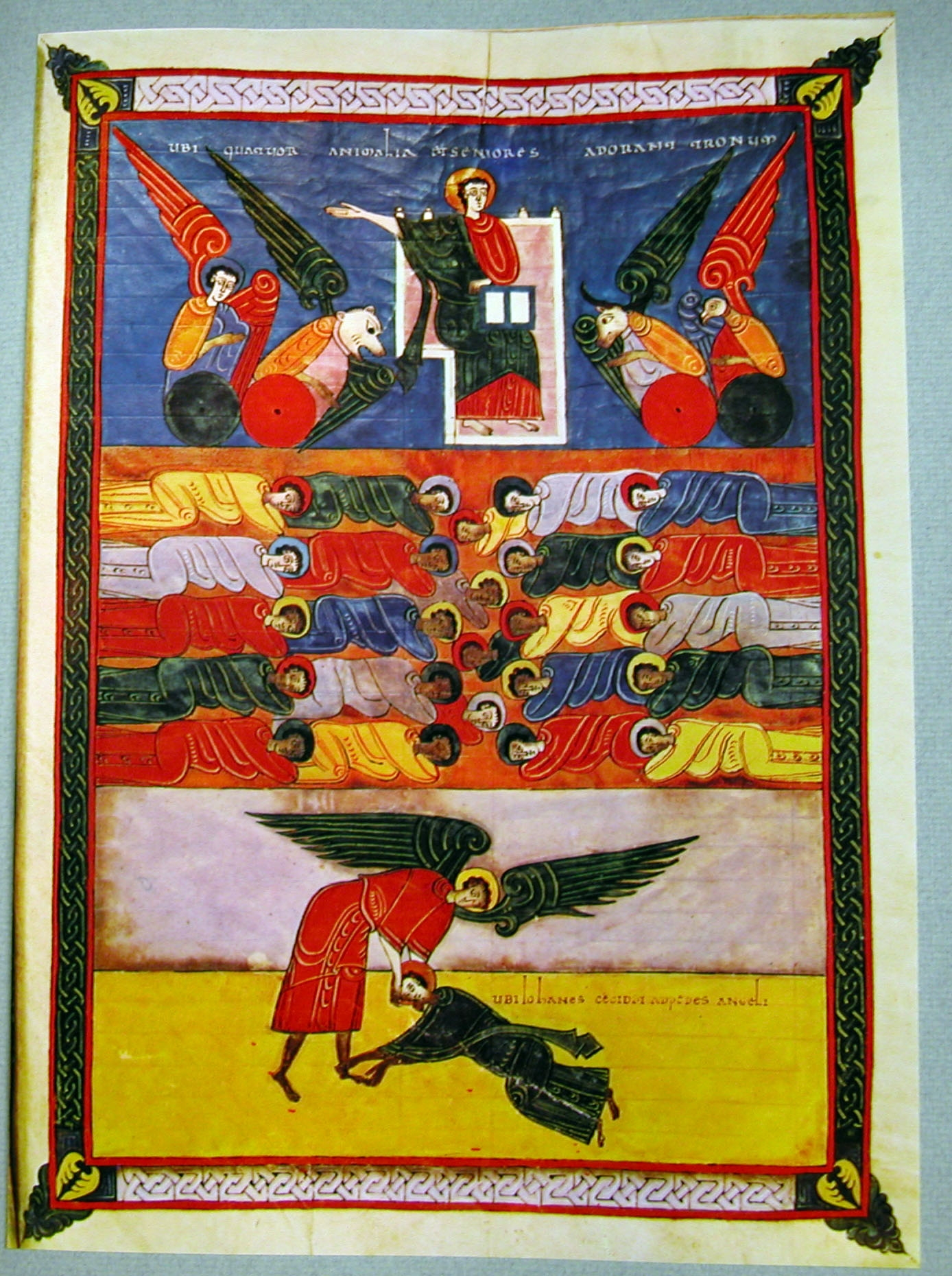A hermeneutic that dictates that artists do as little original work as possible (rather than as much as they can), is one that respects the past and, paradoxically, allows for the development of steadily better work in the future.
Painting the Nude: The Theology of the Body and Representation of Man in Christian Art
In this book, Clayton provides us with a synthesis that places all within the context of the greater tradition of Catholic thinking on these topics and shows how, far from being a radical departure from it, the Theology of the Body is reinforcing a traditionally Christian and conservative approach to the nude in art. - Deacon Keith Fournier
Two Schemas for Liturgical Art in the 15th Century: Can You Identify These Saints?
Why Portraying God as a Gray-Haired Man Offers Hope to Radical Feminists
So much of today’s gender wars and identity politics, I feel, emanate from a poor grasp of the Christian understanding of both human and divine love. It is more common, through the popularization of the Theology of the Body, to focus on nuptial love as a type for God's love, and rightly so. But we should be careful not to neglect what the types of paternal and maternal love tell us about God's love too.
Meditation, Contemplation and Transformation; Praying With Sacred Art
In the Western/Christian tradition meditation and contemplation are two different things and often misunderstood. As a result of the The Beatles and the Maharishi Yogi, the words are often used interchangeably to apply to meditative practice of Eastern religions, which is different and less effective, in my experience, than the methods of Christian mysticism.
How to Pray With Sacred Art
The short answer to this question is just this: pray as you would normally, but look at sacred art as you do it. Good sacred art will promote a right attitude through the combination of content, compositional design, and stylistic elements. In this sense, the artist does the hard work in advance to make it easy and natural for us.
Is Nudity Appropriate in Christian Art?
Nudity has long been a staple of fine art, but many people feel it is inappropriate for an artist who is also a faithful Christian to portray nudity in their work.
Is it? The answer, as is so often the case in matters of faith and morals, is - it depends.
To modern sensibilities art is decoration. Usually, we are not called upon to look past the surface of what is presented. And so we focus on the external, that which we can see.
But creation consists of what we can see and what we cannot see, the visible and the invisible. It is the role of the artist to create work that draws us past the surface, what we can see, to contemplate the transcendent truth that is presented to us, that which we cannot see.
Pattern, Geometry, and Abstract Christian Art
"Geometric pattern is the abstract art of Christianity."
We tend to think of abstract as something that has come about only within the last one hundred years. But liturgical artists have had their own form of abstract art for nearly two thousand years. Geometric pattern is the abstract art of Christianity.
God made all of creation, visible and invisible, to teach us about Himself. When we perceive the order and pattern that is inherent in creation, the numbers that underlie all of creation, we see the thumbprint of God.
Geometrical forms, built up from mathematical (numerical) forms, are a symbolic expression of Christian Truth. They represent the thoughts of God.
In the Christian world, numbers have both a quantitative meaning and a qualitative meaning. They tell us the amount of some thing (quantity) but they also tell us about the thing itself. (qualitative.)
A carton of a dozen eggs, for example, holds a quantity of 12 eggs. But the number 12 also has a symbolic meaning. it may represent the 12 tribes of Israel, the 12 apostles, 12 signs of the zodiac, or 12 months of the year. Which of these symbols the number represents will depend on the context in which it is used.
In the context of a work of sacred art, depending on the other elements of the work, 12 eggs could represent the New Covenant, a new Church emerging from the "sealed tomb" of the old Law, resting on the foundation of the twelve apostles.
But this qualitative and quantitative language of numbers can also be used to construct abstract, i.e. non-representational, patterns that can lead us to contemplate heavenly things. Medieval manuscript paintings often have a geometric pattern serving as the background as a symbol of the order of heaven.
The work above is a design for a church floor, completed as part of the Masters of Sacred arts program at Pontifex University. It incorporates a specific type of scrolling pattern known as a guilloche. This is a meditation on Christ in the form of a geometric pattern.
Down the middle axis of the design are three shapes. The first shape at the top contains the symbol for "alpha," the first letter of the Greek Alphabet, The bottom shape holds the symbol for "omega," the last letter. Alpha and omega, the first and the last, the beginning and the end, come together in the middle in a "Christogram" a symbol representing Christ. Jesus Christ is the alpha and the omega, the first and the last, the beginning and the end. Christ is the mediator between man and God. In the ancient world, the number "2" was a mediator between the numbers 1 and 3. The number "2" then, represented a mediation between two extremes, heaven and earth, divine and human, God and man. We might also say then that Jesus, the second person of the Holy Trinity, mediates between God the Father and God the Holy Spirit.
Flowing around these central shapes is a bough of laurel leaves in a guilloche pattern. Laurel leaves are a symbol of victory, Christ is victorious over sin and death. The laurel bough weaves around eight medallions which contain another type of Christogram, in this case a cross and the letters INRI. They serve to remind us that Christ obtained His victory through death on a cross, a death at which He was proclaimed Jesus of Nazareth, King of the Jews.
And "eight" medallions also have a hidden meaning. Eight is the number of the victorious resurrected Christ and a redeemed world. Eight is the sum of "7" the number of totality and completion, and the number "1," representing the singularity of God. The number "8" is used in baptismal fonts as a symbol of a new life brought from darkness into light.
The victorious Christ is the eight day, heralding a new birth and a new creation. He brings the world from darkness into light.
There is no reason we cannot imbue the design of our churches with such geometric patterns and symbols that hold a rich symbolic language revealing the truths of the invisible world that are hidden within the visible. All it takes is the knowledge, and the will.
this article originally appeared at www.DeaconLawrence.org
______________________________________
Pontifex University is an online university offering a Master’s Degree in Sacred Arts. For more information visit the website at www.pontifex.university
Lawrence Klimecki is a deacon in the Diocese of Sacramento. He is a public speaker, writer, and artist, reflecting on the intersection of art and faith and the spiritual “hero’s journey” that is part of every person’s life. He maintains a blog at www.DeaconLawrence.org
Rose Windows and Sacred Geometry - the Ancient Mystical Path to God
I have just been creating a new online course on the mathematics of beauty and as part of this, I wanted to show how to represent the symbolic meaning of number in the context of the liturgy in such a way that it might deepen participation. The obvious way to do this is to have a pattern with the symmetry of the number. This will require also some catechesis of the congregations so that they are reminded of what it is pointing to every time they see it. It can be part of the decoration of the church, incidental, as it were, to the structure:
Or it can be more intimately and obviously bound with the form of the church, as it is in the medieval rose window. Here is a window dating from about 1500 in the cathedral at Amiens in France:
It is important to awaken our innate sense of the symbolism of the natural world and all that is created as this stimulates also our natural sense of the divine. The awe and wonder that we feel when we contemplate the world around us is, for all that it seems profound, little better than a shallow emotion generated artificially by a drug if we stop there and do not allow it to draw us closer to its source - God. This is its true consummation, we are made to see the glory of God in his creation and it will be to his greater glory and our greater joy if we allow the beauty of the world to take us to what it points to.
We can consider this to be a form of relation. Creation is in relation to its Creator. By virtue of its existence, it is relational, for it is connected to its Creator by the mark of divine beauty He has impressed upon it. This interconnectivity of all that exists, therefore, is not a mental construct thrust upon the cosmos artificially by mankind. Rather it is a property of the object that we see. All being is relational by nature and is patterned lattice that has the Creator at its heart.
As created beings ourselves, we participate in this dynamic too, seeing a natural connection between ourselves and the rest of the cosmos. All of mankind is endowed by the Creator with an intellect and the capacity to observe the world around us in such as way that it can derive from it an understanding of our place within it, and ultimately this points to and sheds light on our relationship with the Creator.
Part of our task as people seeking to evangelize the world is to re-awaken the final link in the chain of connection between creation and Creator by re-establishing a culture that is rooted in this principle of interconnectivity through its beauty. This process of evangelization of the culture begins in the church in which all that we perceive and all that we do participates in this language of symbol and is there to connect us to God.
Coming back to the symbolism of number, it is widely accepted, even in the secular culture, that the natural world is connected to mathematics. The connection is so strong that few, if any, doubt, for example, the power of mathematics to help the natural scientist to describe the processes of the natural world. However, I think we should stop for a moment and think about this - it need not automatically be the case. Once I realised this it became a source of great wonder to me that the abstract world of mathematics is so intimately bound in its structure with the behaviour of the natural world.
This had to be noticed before the connection could be made, and it is why figures such as Boethius commented, in his De Institutione Arithmetica, (Bk1, Ch.2) that 'number was the principal exemplar in the in the mind of the Creator' and from this is derived the pattern of its existence that the scientist observes.
The natural scientist of today is generally less aware of the symbolism that runs through both nature and mathematics. The medieval thinker would not have rejected method of today's natural scientists I suggest but would have added to his description of the natural world the symbolic language of number, which is largely forgotten today. If scientists were to do this today, I suggest that it would inform his work in such as way that technology would both enhance his work as a conventional scientist and allow its applications to become more in harmony with the flourishing of man. Rather than being in conflict with today's scientist, the proponent of sacred number has something that can help him to be a better scientist.
Geometry is a way in which number can be expressed in space through matter, and so this is why geometric patterned art ought to be right at the heart of the evangelization of the culture and any sacred art. It is also why the study of the symbolic meaning of number in conjunction with the study of geometry is so important in a Catholic education today. What I propose is a study of geometry that is so much deeper, and more exciting than the dull task of memorizing Euclidian proofs (which sadly seems to be the way it is taught in Great Books schools today). This is about connecting the pattern of the universe to the creative impulse of man so that the beauty of the culture can direct us to God even more powerfully than the most beautiful sunset you have ever seen.
And so this is why I would like to see the rebirth of the Rose Window, in our new churches. This is more than simple decoration, if done well it has the power to stimulate in us a profound sense of our place in the world and in relation to God. Always assuming that even if we got as far as seeing them in churches, the catechesis available would be minimal or poor (we're Catholics!) these would need to be designed in such a way that the symbolism was obvious. There is nothing stopping words and scriptural quotes being added, just as we must in figurative art, in order to clarify, for example.
Here I give some examples of such windows with, three, four, five and sevenfold symmetry. I have obtained these photographs from a great resource that I discovered online called therosewindow.com, run by Painton Cowen, who kindly gave us permission to reproduce his photographs here. This site has photos of windows based upon numbers that you don't normally associate with Christian symbolism - 11 and 13 for example. I would want to consider carefully the basis of these before replicating them today. We must learn from the past, but we must be aware also that not everything that it tells us is true!
Here are some images.
Three, 15th century, Barrien, France:
Four and three in a quincunx arrangement of five objects, 15th century, Agen, France
Five, Exeter, England, 13/14th century:
Seven, Beaulieu en Rouergue, France, possibly 14th century:

If you want to know more about the symbolism of number and the philosophy behind it, I suggest that you either read The Way of Beauty or take the course, the Mathematics of Beauty which will soon be offered at www.Pontifex.University, Master's in Sacred Arts program.
In the meantime...believe it or not, lucky thirteen! Larino Duomo, Italy,
A Processional Cross by Philippe Lefebvre
Here is a newly completed wood polychrome and gilded processional cross made by Frenchman Philippe Lefebvre. I love the balance of naturalism and subtle abstraction that he has incorporated into this. In Mediator Dei, Pius XII said, you may recall: 'Modern art should be given free scope in the due and reverent service of the church and the sacred rites, provided that they preserve a correct balance between styles tending neither to extreme realism nor to excessive "symbolism," and that the needs of the Christian community are taken into consideration rather than the particular taste or talent of the individual artist.'
He is telling us that the Christian artist must represent natural appearances and through the medium he chooses reveal also the invisible truths of the human person ('symbolism'). There is wide scope for individual interpretation of how this might be done, even when working within the forms of an established tradition. It is incumbent upon each artist to find the balance that appeals to people of his day. This may mean working precisely in the way of the past, or adapting and building on the past in order to achieve this end and create something new. In doing so he must avoid the errors of straying too far in either direction, towards extreme naturalism ('realism') or abstraction.
Why All Christian Artists Must Learn to Draw - And Where You Can Learn To Do It Well
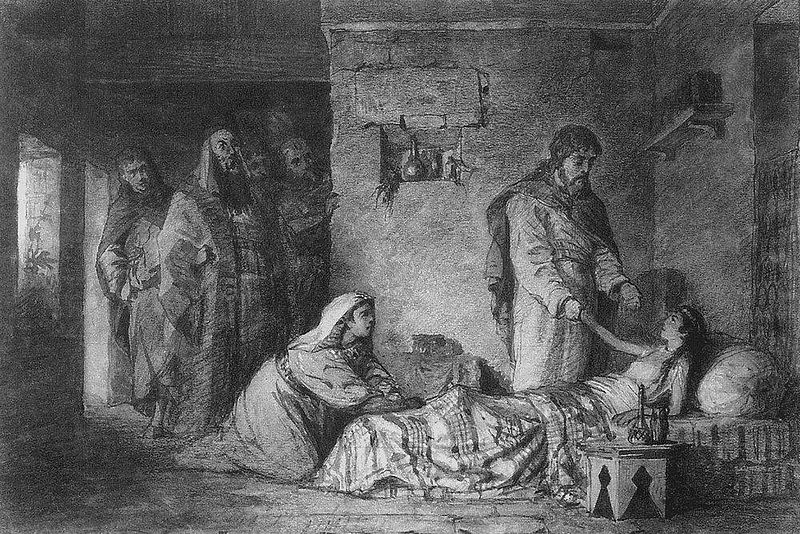 Summer Drawing Classes in the Academic Method at the Ingbretson Studios, Manchester NH
All figurative Christian art, and especially sacred art, is a balance between natural appearances and idealisation. Idealisation is the controlled distortion from natural appearances that enables the artist to communicate invisible truths.
Summer Drawing Classes in the Academic Method at the Ingbretson Studios, Manchester NH
All figurative Christian art, and especially sacred art, is a balance between natural appearances and idealisation. Idealisation is the controlled distortion from natural appearances that enables the artist to communicate invisible truths.
Some people assume that working in a style such as the gothic or iconographic is easier than in more naturalistic styles, but in fact to be able to work in a style well is takes great skill. The artist must be aware of span the divide between the two worlds he is representing. If there is too great an emphasis on natural appearances, then it lacks mystery. If the distortion so too great, then we lose a sense of the material. Artists should be aware too, that in sacred art the degree of naturalism should be less than in mundane art - for example landscapes and portraits.
Pius XII spoke of this in Mediator Dei (195) he refers to this balance (he uses the word 'realism' for my naturalism; and 'symbolism' for my idealism): 'Modern art should be given free scope in the due and reverent service of the church and the sacred rites, provided that they preserve a correct balance between styles tending neither to extreme realism nor to excessive "symbolism," and that the needs of the Christian community are taken into consideration rather than the particular taste or talent of the individual artist.'
The first step in getting this right is studying the tradition to develop a sense of where the balance lies. Even so, different artists will have a different sense of exactly where this balance lies, but even recognition of the fact that there can be excessive naturalism and excessive abstraction and that he should seek the temperate mean goes a long way to getting it right.
The second step is getting the skill to represent precisely both the naturalistic and the idealistic (by reflecting accurately the idea of the mind in the artist). The artist who cannot draw well from nature cannot do this, for no matter how well conceived his ideas may be he cannot represent them accurately if he cannot draw well. Therefore learning to draw well is an essential part of the training of any artist. Regardless of the style in which he ultimately intends to paint in, I would recommend everyone to learn to draw rigorously. The best drawing training that I know is the academic method. I spent a year learning this in the Florence atelier of Charles H Cecil with the blessing of my icon painting teacher even though the style is very different. As a result the quality of my icon painting went up by orders of magnitude. A danger of learning the academic technique is that of being so dazzled by how ones drawing improves that one forgets that technique is only the means to an end and not the end. The artist must realise that he cannot succeed on technique alone and so should not neglect the development of his understanding tradition and how to direct those skills in the service of God.
Those who wish to learn this technique can come along to the Thomas More College summer school art program. This is done in conjunction with the world reknowned Ingbretson Studio, featured here:
https://www.youtube.com/watch?v=fbtBW2T50p0 In this class a day spent in the studio is supplemented by a series of lectures explaining the basis of the tradition and placing the use of it within the context of Catholic sacred art so that you always control the technique in the service of the Church.
Just to illustrate the level of drawing skill achieved by the academic method. Here is work from the Russian 19th century Master Vasiliy Polenov. He is highly skilled. You can see a couple of examples of his drawings including one of a bibilical scene - the raising of the daughter of Jairus. I have also included a couple of his landscapes.
In my personal judgement, he was a superb draughtsman and has dazzling technical skill. This works wonderfully in the landscapes. However, it is not sufficiently abstracted or symbolic for sacred art and so his bibilical scenes look more like what we used to seeing as color plates in children's bibles than devotional art. It is interesting to note that in Russia in the 19th century, this is how art for churches was painted and part of process of reestablishing the Russian iconographic tradition, which happened in the 20th century as reaction to this by figures at the turn of the last century such as Fr Pavel Florensky. His analysis was then picked up by painters such as Ouspensky and Kroug in the mid-20th century.
The purpose of this not to argue against the validity of the academic training. In fact it is the opposite, I would argue that it has great value; but if one is to use it in the services of sacred art, one must be aware of how to direct that skill towards the right balance of naturalism and idealism. This is the special element, expressed in an explicitly Catholic way, is included in the classes I have described above, and which is absent from nearly all others.
Below: first, the raising of Jairus' daughter in full, then a drawing - portrait of an art critic; a superb landscape of a Russian rural scene; then two bibilical scenes - 'he who is without sin' and the boy Jesus found in the temple teaching the teachers. By way of contrast I show Duccio's version of the same subject that has a much more abstracted style.
And here is a poster for the summer drawing class run by TMC and the Ingbretson Studios
Stations of the Cross - Some New Images in the Gothic Style
 On Good Friday, here are some images for the season. A reader has directed my attention to the paintings of this London based Catholic painter. She bases here style on the 14th century Italian gothic style. I am encouraged that she is developing so well a voice, so to speak, that is characteristic of the Western tradition. I am reminded of the Florentine painter Lorenzo Monaco, whose paintings I used to see regularly in the National Gallery in London when I lived there. The link for the full set on her website is here; and to her notes on the commission here.
On Good Friday, here are some images for the season. A reader has directed my attention to the paintings of this London based Catholic painter. She bases here style on the 14th century Italian gothic style. I am encouraged that she is developing so well a voice, so to speak, that is characteristic of the Western tradition. I am reminded of the Florentine painter Lorenzo Monaco, whose paintings I used to see regularly in the National Gallery in London when I lived there. The link for the full set on her website is here; and to her notes on the commission here.
These new Stations were blessed by the Bishop of Norwich at Wymondham Abbey on Laetare Sunday.
There is one point of consideration here and that is the choice of painting the buildings in the style of 14th century Italy and some of the figures dressed in clothes contemporary to that period (we see that in the 5th station particularly. When painted, these were echoes of what the world around them looked like at that time. One might argue that today, if we were to adopt the same principle, we would be showing modern buildings and modern clothes painted in a gothic style. It is difficult to imagine, but it is the job of the artist to imagine for us. This is the talking point that I brought up recently in connection with my own work in the style of the English School of St Albans. I painted a pious knight in chainmail and wondered if I should have been painting a pious Wall Street trader in pinstripe suit as a modern equivalent!
On the other hand it might be argued that although not historically accurate representation of Palestine of 2000 years ago is nevertheless convincing to the modern viewer in regard to sacred art. We are not concerned with strict historical representation provided the principles that we do wish to convey are communicated, and the style is certainly the right balance of naturalism and abstraction that one would want to see. One could argue therefore, that it evokes another age sufficiently for us to acknowledge that this event took place historically in the past and then we move past that and on to the spiritual lessons.
Christ meets his mother
Christ's Second Fall
Christ is nailed to the cross
From Sacra Liturgia, Rome: Beauty is a language without words and must be present in art and architecture
 Here is a report of the presentation on architecture and art by Fr Michael Lang of the Brompton Oratory at the Sacra Liturgia 2013. I hope I have done it justice.
Once again this was posted first on Catholic Education Daily. This is blog of the Cardinal Newman Society which seeks to spur on liturgical renewal in Catholic higher education, so I was very happy to be asked to report on the conference for them; and to make NLM readers aware of the efforts they are making in this direction as well as what went on in the report.
Here is a report of the presentation on architecture and art by Fr Michael Lang of the Brompton Oratory at the Sacra Liturgia 2013. I hope I have done it justice.
Once again this was posted first on Catholic Education Daily. This is blog of the Cardinal Newman Society which seeks to spur on liturgical renewal in Catholic higher education, so I was very happy to be asked to report on the conference for them; and to make NLM readers aware of the efforts they are making in this direction as well as what went on in the report.
In this presentation Fr Lang stressed the need for liturgical forms that are in harmony with with well directed worship and for informed patronage; and a dialogue between artist and patron in the planning stages. In his presentation he did not rely on personal opinion as to the quality of the architecture he was showing (the opinions expressed in the article about particular churches are mine not his). Rather, he laid out the processes by which the architect was commissioned, and told us the (often absurd and grandiose) aims articulated by the architect. Then, dispassionately, he compared the stated aims with the requirements of the traditions of Church pointing out differences and contradictions if they occurred. Then without further comment after this analysis he presented us with a photograph of the final product, allowing us to make up our minds. The laughter of the audience said it all. I did not notice Fr Lang even crack a smile as he did this, which just seemed to add to the deadpan humour.
He finished by giving us some guiding principles that he felt that patrons should focus on when commissioning art and artchitecture and that might avoid some of the errors of the last 100 year.
Once again, the full article is here.

Every Artist Should Read This Book
 The Techniques of Icon and Wall Painting by Aidan Hart. This is the best art instruction book I know of. In my opinion it should be read and absorbed by all artists regardless of the medium and the tradition they are working in. It is available in the US from Holy Trinity Bookstore, and in the UK from publisher Gracewing's website, here. It has 480 pages, 450 illustrations and 130 drawings. It comes in hardback and costs 40GBP or $70.
Aidan Hart does a wonderful job in explaining the methods of the media that he works in: egg tempera, fresco, secco and gilding, with great thoroughness and right through to varnishing and even photographic artwork for publicity shots. As an experienced practitioner and teacher he anticipates the difficulties and questions of the students at every turn. At every stage links what is done to the underlying principles of the tradition, and this opens the door to so much more.
The Techniques of Icon and Wall Painting by Aidan Hart. This is the best art instruction book I know of. In my opinion it should be read and absorbed by all artists regardless of the medium and the tradition they are working in. It is available in the US from Holy Trinity Bookstore, and in the UK from publisher Gracewing's website, here. It has 480 pages, 450 illustrations and 130 drawings. It comes in hardback and costs 40GBP or $70.
Aidan Hart does a wonderful job in explaining the methods of the media that he works in: egg tempera, fresco, secco and gilding, with great thoroughness and right through to varnishing and even photographic artwork for publicity shots. As an experienced practitioner and teacher he anticipates the difficulties and questions of the students at every turn. At every stage links what is done to the underlying principles of the tradition, and this opens the door to so much more.
First, once the parameters that define the tradition are well understood, it gives the student the flexibility to start creating original work without straying beyond its bounds. Hart takes us step by step through that process.
 Second, for those working in other traditions it gives a deep understanding as to how form (ie style), choice of medium, compositional design, even the framing is affected by the invisible truths that the artist is seeking to communicate. The way I paint man is determined by anthropology – my understanding of what a man is. The reason that we can distinguish between different traditions, for example the gothic and the iconographic, is that each is seeking to emphasize different aspects of the anthropology. Understanding how the iconographic tradition is governed by these considerations will help artists in other traditions, for example the baroque, to see how the theology governs the form of their chosen tradition as well.
Second, for those working in other traditions it gives a deep understanding as to how form (ie style), choice of medium, compositional design, even the framing is affected by the invisible truths that the artist is seeking to communicate. The way I paint man is determined by anthropology – my understanding of what a man is. The reason that we can distinguish between different traditions, for example the gothic and the iconographic, is that each is seeking to emphasize different aspects of the anthropology. Understanding how the iconographic tradition is governed by these considerations will help artists in other traditions, for example the baroque, to see how the theology governs the form of their chosen tradition as well.
The first two considerations are what transforms an artistic style from pastiche into living tradition, that is capable of developing and responding to its time, without compromising its core principles.
Third, he gives a simple and easily understandable explanation of the different variations within the iconographic traditions, and unusually, includes the Western variants such as Celtic, Carolingian, Ottonian and Romanesque icons and explains just why they are iconographic.
Aside from this even much of what he is teaching at a technical level is of use to all painters: especially colour theory, harmonization of design, and the different attributes of using line and tone to articulate form. Although vital, drawing skill is not enough. Hart has as well a wonderful sense of composition and colour harmony and this book gives us great insights into how he does it. He shows us that as well as experience and good judgment, there are many guiding principles that the artist can make use of. For example, as well becoming lighter and darker, colours actually change in light in shade – a green might become bluer in shadow, rather than simply dark green. Aidan explains sytematically, colour by colour, how to adjust for light and dark so as to keep a coherent, unified image. In my opinion it is worth buying the book for his personal insights in this area alone.
![]() All this is supplemented by over 400 pictures, which include not just complete pictures of paintings, but also many which focus on small details that what he describes in the text.
All this is supplemented by over 400 pictures, which include not just complete pictures of paintings, but also many which focus on small details that what he describes in the text.
Aidan Hart is Orthodox, but he does not snipe at the Western Church (as sometimes happens with other Orthodox writers) and so Catholics can read and enjoy it without worry. That said there is one small note of caution: in accordance with St John of Damascus, he describes the icon as being ‘grace bearing’. Catholics should be aware that their own tradition can describe it slightly differently. In accordance with the 9th century Eastern Father St Theodore the Studite, it tends see the action of the icon as one that is analogous to a sacramental, ie, that seeing it makes us more susceptible to the action of grace, but it is not in itself a channel of grace. I discuss this more deeply in a previous article, here.
This book is recommended as reading for anyone interested in sacred art and will, I believe do much in the future to aid the development of sacred art in the Church. Well done Aidan Hart.
Should a saint always have a halo? And should it always be round?
When I was learning to paint icons I was taught that the halo is not simply an arbitrary symbol, but rather a direct representation, albeit stylised, of the uncreated light shining from the saint.This immediately raised the question in my mind as to the validity of some halos I had that were in the form of a detached floating hoop, as we might see in a Raphael or a Leonardo (whose painting is shown below). Although clearly derived from this original idea, it's form had drifted so that it could no longer be seen as uncreated light, but rather an abstract symbol. Initially, my reaction was to argue that this form indicated a lack of understanding of what the halo really is and should not be used.
Then it occured to me that given that the art of the High Renaissance and Baroque is aiming to portray historical man (and not as with the icon eschatological man united with God in heaven), what the artists are doing might in fact be consistent with this. One might propose that because the aura of uncreated light, the nimbus, would not be as visible (to the same degree at any rate) in fallen man, even if that man is a saint. So it would seem that the artist might choose not to portray a halo very feintly, as a slight glow, or even not at all; or else to indicate sanctity with a symbol derived from the heavenly sign. We see each of these possible avenues in the art of the 16th and 17th centuries.
 As a complication to this, recently I became aware of different shapes of icons in both Eastern and Western traditions. I was giving a lecture at Thomas More College about the portrayal of the Trinity in art and one of the students asked about the triangular halo in this example of an iconographic fresco fo the Trinity at a monastery in Mt Athos. I hadn't really thought about this before and guessed that it was an indication of the Trinity but couldn't really account for it with any certainty. Then, the next slide up in the lecture there was a Velazquez with the same triangular halo portrayed as a detached floating triangle on the same person of the Trinity, God the Father.
As a complication to this, recently I became aware of different shapes of icons in both Eastern and Western traditions. I was giving a lecture at Thomas More College about the portrayal of the Trinity in art and one of the students asked about the triangular halo in this example of an iconographic fresco fo the Trinity at a monastery in Mt Athos. I hadn't really thought about this before and guessed that it was an indication of the Trinity but couldn't really account for it with any certainty. Then, the next slide up in the lecture there was a Velazquez with the same triangular halo portrayed as a detached floating triangle on the same person of the Trinity, God the Father.
Later , when digging around a bit to find an explanation I found this site, which gave lists of many different halos, here. This listed quite a number of traditional halo shapes, most of which I had not been aware of. While not always showing a clear understanding of the Catholic view of things, this is good resource, I think, not to say unusually attractively presented for a website.
So there are two different considerations that come out of this. First, in more naturalistic traditions, should it be retained. And second, should we change the shape of the halo in different situations?
My opinion on the first is that we can happily follow the example set by the Masters of the Baroque tradition and employ whichever solution of the three list the artist prefers, for each, it seems to me, is consistent with the theology.
 In regard to the second point: for me the debate is similar to that in regard to all the traditional symbols. Symbolism is only useful if it helps to communicate truth. If only a few understand it, it does the opposite, it mystifies. We have to consider this when considering whether or not to resurrect a symbolic language of the past. So if the symbolism is intuitively obvious then it might be worth using; otherwise we would need a huge job of education just to get people to recogniseit. This effort would be to great to make it worthwhile, I suggest, except where that symbolism is drawn directly from scripture.
In regard to the second point: for me the debate is similar to that in regard to all the traditional symbols. Symbolism is only useful if it helps to communicate truth. If only a few understand it, it does the opposite, it mystifies. We have to consider this when considering whether or not to resurrect a symbolic language of the past. So if the symbolism is intuitively obvious then it might be worth using; otherwise we would need a huge job of education just to get people to recogniseit. This effort would be to great to make it worthwhile, I suggest, except where that symbolism is drawn directly from scripture.
In regard to triangular halos: it is not drawn from scripture - I am not aware, for example, of Ezekiel describing visions of triangular halos; but you might say that when placing a triangle over God the Father, in these examples shown, because the known symbolism of three, that it is to large degree intuitively obvious what it is saying, so for this reason might be worth using.
In my own case, while I would not object to any other artist using a triangular halo for the reasons given above, I think am going to keep it simple stay pretty simple on halos: a gold disc for eschatological man, and no halo for historical man. This is just a personal choice based upon what I feel looks best.
From top: A triangular nimbus in an iconographic portrayal of the Trinity at a monastery in Mt Athos, Greece; the halo represented as 'floating' triangle and disc in Velazquez and Leonardo in more naturalistic styles of Baroque and High Renaissance respectively; and the 17th century baroque approach in Guido Reni's St Matthew portrayed without halo of any form.
Illumination of the Prayer of Dona Ximena in the Poem of El Cid by Alana Kelley, student at Thomas More College
 An original work of art in the Spanish Romanesque style of the Morgan Beatus Manuscript.
My colleague at Thomas More College Dr Christopher Blum called me into his office the other day. He was keen to ask my opinion on a piece of art work handed in by student, Alana Kelley for his medieval literature class. He showed me the manuscript shown left. I immediately recognized this as the Spanish, Romanesque style as exemplified in the 10th century Morgan Beatus manuscript. She has created an original work of art in this style to illustrate the Spanish classic poem of El Cid. There are some examples of the Spanish illuminations below.
An original work of art in the Spanish Romanesque style of the Morgan Beatus Manuscript.
My colleague at Thomas More College Dr Christopher Blum called me into his office the other day. He was keen to ask my opinion on a piece of art work handed in by student, Alana Kelley for his medieval literature class. He showed me the manuscript shown left. I immediately recognized this as the Spanish, Romanesque style as exemplified in the 10th century Morgan Beatus manuscript. She has created an original work of art in this style to illustrate the Spanish classic poem of El Cid. There are some examples of the Spanish illuminations below.
Alana is a gifted artist who has now attended two icon painting classes of mine at the college and devoted a semester of Saturdays learning academic drawing at the Ingbretson Studio. What is particularly gratifying for me is how intelligently she has made use of the techniques she had learnt and produced something that is in harmony with literature she is studying. In regard to this particular piece it was all without any input from me at all – it was submitted at part of a medieval literature class, not an art class.
Dr Blum told me: ‘It was in response to an assignment that invited the students to create an original work of art modeled upon or inspired by the medieval texts that we studied. As well as Alana’s painting there were a number of conventional essays submitted, but also four lengthy poems, three plays, two paintings, two illustrated books, two recitations (from memory, of course) of medieval verse, one performance of medieval songs, and an original piano sonata inspired by the First Crusade's Liberation of Jerusalem. What most impressed me about the whole class's response to the assignment is that they plainly understood that the cultural achievements of the past are not museum pieces meant to be dead on a wall, but living works, continually inspiring our own reflection upon the good, the true, and the beautiful.
‘As to Alana's painting: I was especially delighted in her choice of theme, because the prayer of Dona Ximena in the Poem of El Cid is, to my mind, one of the most stirring examples of the way in which the Christian faith shaped the imagination of our medieval ancestors. The prayer places the human drama in the context of the whole of salvation history and the divine order of the universe, and Miss Kelley's manuscript, by making the text of the prayer a kind of link or middle between the celestial and the earthly realms, reflects the deep Christian identity of the anonymous Castilian poet who left us the Cantar de Mio Cid.’
Looking at it with my artist’s eye, what struck me is how Alana has adopted the compositional style of the Beatus and used orthogonal division of the space. The practicalities of the class meant that she had to work in acrylic, but she investigated additives that would allow her to paint glazes (a dark transparent layer over a lighter) in order to get the effects that I had shown her using egg tempera in the icon painting class. By using successive glazes she has introduced subtle variety and interest into areas that would otherwise by flat monochrome; and by varying the local contrast, for example around the script and around the figures, she has ensured that the eye is drawn to the most important aspects of the composition. The patterned border is typical of Romanesque work and not seen in Eastern icons so often but, again, wholly appropriate for this work.

Alan Kelley's illumination, above, and, below, examples of Romanesque illuminations from the period







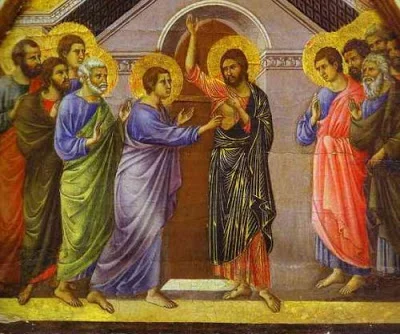
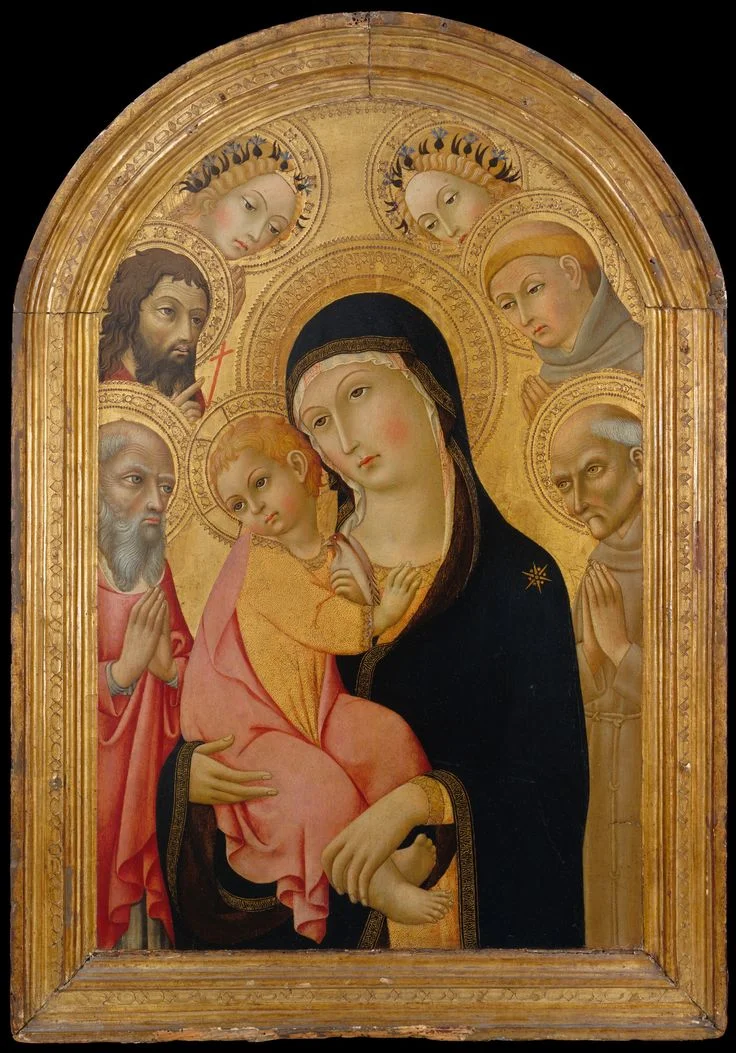






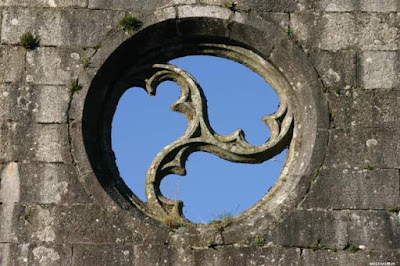


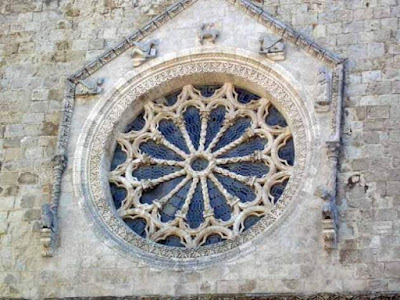
.jpg&container=blogger&gadget=a&rewriteMime=image%2F*)
.jpg&container=blogger&gadget=a&rewriteMime=image%2F*)
.jpg&container=blogger&gadget=a&rewriteMime=image%2F*)
